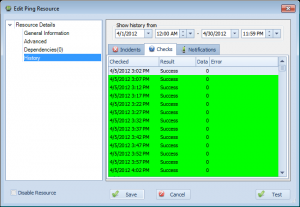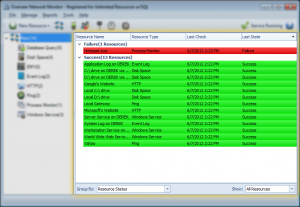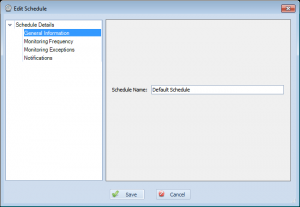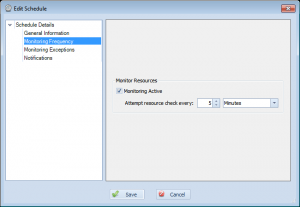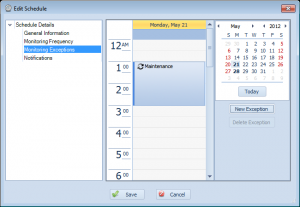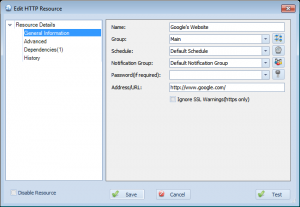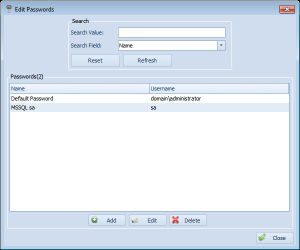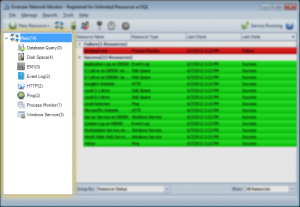Move resource history interface from right click to ‘History’ entry in left tree of Edit Resource dialog
Overseer has supported showing history on resources since the beginning. This can be useful to determine what happened historically, for tracking availability, etc. In previous version of Overseer, this used to be under the right click menu– you had to right click a resource and select ‘Show History’. Unfortunately, this right-click function was often missed by many users– and they had no idea this feature even existed!
With Overseer 5.0, the resource history– including incidents, checks, and notifications sent– is now in the main edit resource dialog. Simply open a resource and select ‘History’ on the left. You can then browse the history easily, using the interface as shown here:
As you can see, this shows the full history of checks, so you can see the history when using Overseer for service monitoring, ping monitoring, disk space monitoring, or any other Windows network monitoring.
Adds the ability to group resources by host/machine in resource view
While other network monitoring software focuses on ‘servers’, Overseer has always been based around ‘resources’. Some users, however, still want to be able to see their resources grouped by server. With Overseer 5.0, I’ve added a feature to the resource view to enhance the ability to group resources:
This allows for grouping resources by these options:
- No grouping – resources are displayed flat, without any grouping
- Resource Type – This groups resources by their resource type(ping, windows service, etc.)
- Host/Machine – This groups resources based on the machine they’re hosted on. Note that for some resource types, such as HTTP, this will simply be the URL– but for windows services, process monitors, disk space, event logs, and more– you’ll see the actual host.
- Resource Status – This groups resources by failure/success status, so you can easily see all the resources that are down together
Enhances text import wizard to support importing multiple fields and more resource types
One of the difficulties with Overseer in the past, has been getting resource configuration data into the software. In Overseer 4.x, we introduced both the auto-discovery wizard and the text file import wizard. The text file import wizard in Overseer 4.x was fairly basic, in that only one field could be imported.
In Overseer 5.x, this wizard has been enhanced to support multiple fields– you can import both the computer name and the service name for services, for instance. This should make it easier to import resources for service monitoring and other IT monitoring purposes.
Changes Edit Schedule layout to hopefully make things easier to understand
Over the years, Overseer has used many different ways to define how often a resource is polled. In Overseer 3.0, this was moved to schedules– each resource was linked to a schedule, which defined how often the resource was monitored, and when notifications are sent. This was a major step forward, as previous to this, each resource had to have these settings set manually.
Even still, some of the settings for schedules can be confusing. In Overseer 5.0, with the new property-tree layout that’s used throughout Overseer, I’ve broken the old ‘edit schedule’ dialog into multiple sections.
General Information
The first is the ‘General Information’ page. Right now, this just has the name of the schedule. This is how you refer to the schedule throughout Overseer.
Monitoring Frequency
The next page is the ‘Monitoring Frequency’ page. This simply defines that resources using this schedule are set to monitor(active yes/no), and how often those resources should be polled.
Monitoring Exceptions
This next page is for ‘Monitoring Exceptions’. This is where you define exceptions to the schedule– such as for maintenance periods.
Notifications
This last page lets you define how notifications are sent. This is generally the most confusing of the pages, but breaking it out into its own page makes it a little easier to understand. The basic idea here, is that this screen lets you define when notifications are sent after a failure is detected(right away, or wait a period of time), how often they get re-sent, and when to stop sending them(when resource recovers, or after a specific period of time or notifications sent). Lastly, you can specify that you want to receive notifications for recovery(generally most people will always want this on)…
Hopefully breaking out what was a far more complex screen into multiple pages here will make Overseer even more easy-to-use network monitoring software.
Changes edit resource form to include tree-based view on left
Overseer 4.x has used a simple dialog to edit all resource types since Overseer 3.0. As we’ve added more features, this dialog has gotten larger and been more and more clunky. With Overseer 5.0, this dialog has been replaced with one that supports a property tree on the left. This is a fairly standard GUI component of modern day software, so we felt this was the way to go. Here’s a screenshot:
As you can see, on the left there is a tree with ‘General Information’, ‘Advanced’, ‘Dependencies’, and ‘History’. Clicking them will change what appears on the right side of the dialog. This allows us to provide far more functionality in the same dialog, and logically spread it out to make Overseer easier to understand and simpler to use IT monitoring software.
Adds the ability to set group/schedule/notification group/passwords defaults in options for all new resources
Each resource created in Overseer has certain fields in common. Most users will use only 1 of each of these things– schedules, notification groups, passwords, and groups… Many more advanced users will use more than one, however. In previous versions of Overseer, these things would always default to the first entry, or to blank for each new resource. This made adding resources more cumbersome than it should be.
In Overseer 5.0, I added the ability to specify the default for groups, schedules, notification groups, and passwords. Simply go to Tools->Options and then select General Settings->Defaults:
This should make Overseer quicker to setup for both paid users and those that opt for using it as free network monitoring software.
Adds the ability to edit multiple resources at once
One of the biggest complaints users have had about Overseer in the past few years, has been the difficulty in maintaining large numbers of resources. If something needs to be changed on all of them, each one must be edited one-by-one. Even though the need for editing these resources has been reduced significantly by using notification groups, schedules, linked passwords, etc., it is still occasionally required.
With Overseer 5.0, this problem is solved– if you have many resources you’d like to edit all at once, simply select them(shift/ctrl+click), and right click->edit resources. This will bring you up with an edit resource dialog where you can easily change settings. If all the resources are of the same resource type, you’ll see resource type specific settings– if you have resources of multiple types, only the common values will be available.
Try it out– this should make Overseer even quicker to use, making it very easy-to-use network monitoring software.
Adds the ability to filter processes by command line as well as process name
Overseer 4.x added support for monitoring Windows processes. This is a very well-used feature by many users– people use it to monitor all sorts of software– to make sure it’s running, and sometimes to make sure it’s not running.
Overseer 4.x was only able to match processes based on process name, however. This made it difficult to match certain processes that were used for scripts, such as cmd.exe or powershell.exe… Overseer would always match multiple processes, and not specifically the one the user was after.
With Overseer 5.0, I’ve added an additional field, allowing you to filter based on the command line– the parameters passed in on the command line are great for determining which process. This is useful for determining if a script is maxing CPU, using excess memory, etc. It can also be useful for IIS application pools, for instance.
Adds the ability to process monitor to notify when process exceeds CPU% threshold
With Overseer 4.x, we introduced the Windows Process Monitor resource type. This has been well received, and now many customers use Overseer as their primary process monitoring software. Overseer already supports monitoring the # of processes, lack thereof, memory consumption, etc. One check that many customer have asked for, however, is failing if the CPU% for the process gets too high.
In Overseer 5.0, we’ve added this feature to our process monitor software. Now, you can set a process monitor resource type to fail if the CPU% goes above a defined threshold.
Adds ‘edit’ button when managing notifications, schedules, etc.
Overseer has used a standard interface for editing items in Overseer for quite a while. This standard interface makes navigating the software simple-to-use. One thing that was pointed out by one user, however, is that there was no ‘edit’ button on the list screen. Existing users of the Overseer network monitoring software obviously know that you just double-click the item to edit it, but this wasn’t clear to all users.
To accommodate this user, and hopefully make things more obvious to other new users, I’ve added an ‘Edit’ button under the list. This is the same as double clicking the item.
Adds filtering abilities to all item(schedule, notifications, etc.) list screens
One of the new features in Overseer 5.0, is the ability to easily filter edit list– when you’re editing schedules, notifications, etc., you can easily find what you’re looking for using a drop-down and a search field, as you can see in this screenshot:
This can be very useful if you have a large number of passwords, notification groups, etc. This is yet another feature that makes Overseer simple-to-use network monitoring software.
Adds resource count to each node of resource group tree on left
Overseer’s interface has almost always shown resource groups on the left, with each resource type underneath, in a tree format. This is a very simple layout that lets the user easily drill down, as they choose. This simple layout is part of what makes Overseer very easy to use network monitoring software.
With Overseer 5.0, we’ve added a simple resource count to each node, indicating how many resources are in that node. This makes it easier to see how many resources you have in any specific group/type, and can save time manually checking by moving to that group/type.
Overseer Debug Mode in 5.0
Occasionally, customer support will require a debug file to aide in resolving a problem experienced with Overseer Network Monitor. Turning on debug mode will instruct Overseer to log a large amount of detail to a plain text log file for review by support. Passwords are NOT logged to this file.
To enable debug mode in Overseer 5.0, please do the following:
- Go to start->run and type ‘regedit’, and click ‘ok’
- Browse to HKEY_LOCAL_MACHINE\SOFTWARE\Sensible Software\Overseer\ on the left side
- On the right side, set the ‘LogLevel’ value to 6
- Restart Overseer Network monitor and the Overseer service
- Recreate the error you’re having or leave debug mode enabled if instructed by support
- Send the files in C:\ProgramData\Overseer\Logs\ to support via Email. If these files are large, you may zip them up or upload them via FTP using credentials received from support.
- Disable debug mode by changing the ‘LogLevel’ value above to zero(0) and restarting Overseer and the Overseer Service.
It is important not to leave debug mode on, as the debug file can get large over time and with time, fill up your hard disk. It could also slow down Overseer and/or your computer if it gets to be a very large text file(gigabytes).
Enhances auto-discovery wizard to allow discovered hosts or manually entered hosts, better check/uncheck in tree, etc.
The biggest and best feature added in Overseer 4.1, was the auto-discovery wizard. This wizard lets you easily setup multiple resources in Overseer by simply polling your network. In 5.0, this wizard has been revamped to be a little smoother, and give the option of discovering hosts from active directory, or using a manually entered list. The wizard also gives you a choice when discovering hosts via active directory, as to which hosts to actually probe– providing you with a full tree if you have organizational units setup in Active Directory.
Finally, once the hosts have been probed, Overseer lets you select the resources in a tree’d manner– easily selecting/deselecting an entire branch of the resource tree at a time– this can save a lot of time in fine-tuning which resources you want selected.
The auto-discovery wizard is possibly the most powerful feature in Overseer, enabling you to be up and running with the Overseer network monitoring software in no time.
Categories:
- How To (28)
- Known Issues (5)
- New Features (36)
- News about Overseer Network Monitor (3)
- Tips and Tricks (55)
- Using the Software (51)
- Windows Monitoring (9)
